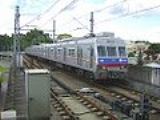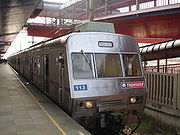
Porto Alegre Metro
Encyclopedia
The Metro de Porto Alegre (Portuguese
: Metrô de Porto Alegre, commonly called Trem) is operated jointly by the federal government, the state government of Rio Grande do Sul
and the city of Porto Alegre
through the company Trensurb (Company of Urban Trains of Porto Alegre SA) and has 20 stations, totaling 33.4 km (17.5 mi) of extension and carries about 170,000 users a day.
 The Line 1 of the subway built in Porto Alegre was started in 1980, linking the center of Porto Alegre to cities to the north of the metropolitan area, as Canoas, Esteio, Sapucaia do Sul, São Leopoldo and Novo Hamburgo. The choice of path was made to relieve the heavy traffic of highway BR-116, only option before the construction of this line, which already had serious problems with the transit at the time.
The Line 1 of the subway built in Porto Alegre was started in 1980, linking the center of Porto Alegre to cities to the north of the metropolitan area, as Canoas, Esteio, Sapucaia do Sul, São Leopoldo and Novo Hamburgo. The choice of path was made to relieve the heavy traffic of highway BR-116, only option before the construction of this line, which already had serious problems with the transit at the time.
The Line 1 was inaugurated on March 2, 1985 between the Central Public Market and Sapucaia do Sul. In December 1997 was extended to Unisinos.
An extension of 2.4 miles São Leopoldo-Museum was added in November 2000, after two months of trial service.
.
Portuguese language
Portuguese is a Romance language that arose in the medieval Kingdom of Galicia, nowadays Galicia and Northern Portugal. The southern part of the Kingdom of Galicia became independent as the County of Portugal in 1095...
: Metrô de Porto Alegre, commonly called Trem) is operated jointly by the federal government, the state government of Rio Grande do Sul
Rio Grande do Sul
Rio Grande do Sul is the southernmost state in Brazil, and the state with the fifth highest Human Development Index in the country. In this state is located the southernmost city in the country, Chuí, on the border with Uruguay. In the region of Bento Gonçalves and Caxias do Sul, the largest wine...
and the city of Porto Alegre
Porto Alegre
Porto Alegre is the tenth most populous municipality in Brazil, with 1,409,939 inhabitants, and the centre of Brazil's fourth largest metropolitan area . It is also the capital city of the southernmost Brazilian state of Rio Grande do Sul. The city is the southernmost capital city of a Brazilian...
through the company Trensurb (Company of Urban Trains of Porto Alegre SA) and has 20 stations, totaling 33.4 km (17.5 mi) of extension and carries about 170,000 users a day.
History

The Line 1 was inaugurated on March 2, 1985 between the Central Public Market and Sapucaia do Sul. In December 1997 was extended to Unisinos.
An extension of 2.4 miles São Leopoldo-Museum was added in November 2000, after two months of trial service.
System Characteristics
The Porto Alegre Rapid Transit has an average distance between each station which is 2 km (1.2 mi), hence the speed communication is of 46 km/h (28 mi) maximum speed of the train is 90 km/h (55 mi/h). The gauge is and feeding of trains is done by 3,000 VDC catenaryOverhead lines
Overhead lines or overhead wires are used to transmit electrical energy to trams, trolleybuses or trains at a distance from the energy supply point...
.
Metro lines
| Line | Start/End | Founded | Distance (km) | Stations | Time (Min) | Hours |
| 1 Azul |
Mercado ↔ São Leopoldo ↔ Novo Hamburgo | 1985 | 33.8 | 17 | 42 | 05:00 AM to 11:20 PM |

